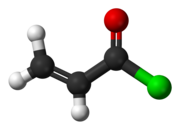Acryloyl chloride

| |

| |
| Names | |
|---|---|
| IUPAC name
2-propenoyl chloride
| |
| Identifiers | |
3D model (JSmol)
|
|
| ChemSpider | |
| ECHA InfoCard | 100.011.272 |
PubChem CID
|
|
CompTox Dashboard (EPA)
|
|
| |
| |
| Properties | |
| C3H3ClO | |
| Molar mass | 90.51 g·mol−1 |
| Density | 1.119 g/cm³ |
| Melting point | N/A |
| Boiling point | 75.0 °C |
Except where otherwise noted, data are given for materials in their standard state (at 25 °C [77 °F], 100 kPa).
| |
Acryloyl chloride, also known as 2-propenoyl chloride or acrylic acid chloride, is a clear, light yellow, flammable liquid with an acrid smell.[1][2] It belongs to the acid chlorides group of compounds and is therefore a derivative of acrylic acid.[3]
Preparation
Acryloyl chloride can be prepared by reacting acrylic acid with benzoyl chloride or with thionyl chloride.[3] When preparing this compound adding a small amount of an inhibitor such as hydroquinone can help to avoid light induced polymerisation of acryloyl chloride.
Reaction
This compound will give the common reactions of acid chlorides: it will react violently with water producing acrylic acid while it will form anhydrides when reacted with sodium salts of carboxylic acids. Reactions with alcohols will result in the formation of esters and reactions with amines will generate amides.
Uses
Acryloyl chloride is most commonly employed in organic synthesis for the introduction of acrylic moieties into other compounds and it is also used extensively in the preparation of acrylate monomers and polymers.
Safety
Acryloyl chloride is a dangerous compound being both easily flammable and corrosive: contact with skin, inhalation and ingestion should be avoided since it can result in burns. Acryloyl chloride should be handled carefully since it is also a lachrymator.[citation needed]
References
- ^ Environmental Chemistry (2007). "Acryloyl chloride". Environmental Chemistry.com (J.K. Barbalace, inc). Retrieved December 21, 2007.
- ^ Physical & Theoretical Chemistry Laboratory (2005). "Safety data for acryloyl chloride". Physical & Theoretical Chemistry Laboratory. Retrieved December 21, 2007.
- ^ a b PatentStorm LLC (2006). "Process for the manufacture of acryloyl chloride". PatentStorm LLC. Retrieved December 21, 2007.
